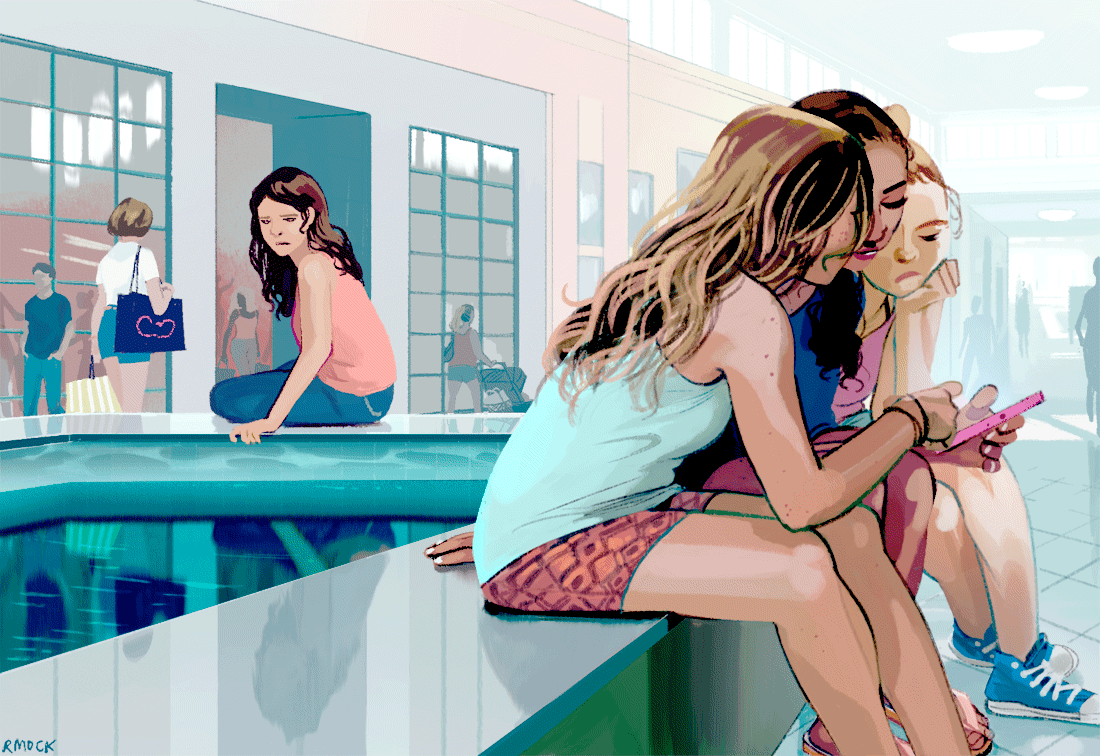

Illustration by Rebecca Mock for TIME
Once upon a time, only the wealthy and privileged could afford to have their portraits painted by a small, select circle of artists. With the advent of photography, parents of all backgrounds could have pictures of their children, which were coveted as documents of their development and a way to show off their innocent beauty and charm to family and friends.
Today, with smartphones and social media, we all have in our hands the means to broadcast our pride and joy to the world. And we are cultivating our children’s online selves from birth—or even before, in utero. Ninety-two percent of American children have an online presence before the age of 2. Parents post nearly 1,000 images of their children online before their fifth birthday. “Sharenting” has given parenting a whole new dimension: viewer-rated performance.
The usual debate centers on whether posting pictures of one’s children’s online—or allowing one’s children to do so—is safe from a privacy or security standpoint. And as we have seen in the recent abduction and murder of 13-year-old Nicole Lovell of Blacksburg, Va., concerns about online predators are more than just a moral panic: they stem from something real. Lovell reportedly texted with one of her alleged killers, 18-year-old David Eisenhauer, a Virginia Tech student, on Kik Messenger, an app known among kids as a place for the exchange of sexts and nude selfies.
But while we’re consumed by the tangible dangers of messenging services like Kik, Yik Yak, After School and other anonymous apps, we may be missing a different influence: our own behavior. Kids today are often accused of being narcissistic, but they may be learning their exhibitionist ways from their parents. Accompanying the boom in selfie culture is a rise in competitive spirit, as well as a disturbing trend of sexualization. Likes, hearts, swipes—validation is only a tap away. And one of the easiest ways to get that validation is by looking hot. Sex sells, whether you’re 13 or 35.
So it should come as no surprise that in this atmosphere, with the new technology available, sexting and sharing nudes have replaced other forms of intimacy. And it’s girls—our daughters, granddaughters and nieces—who are most at risk in this online environment, which blends age-old sexism with a new notion of sexual liberation through being provocative.Girls who post provocative pictures often suffer slut shaming on- and offline. Girls are more often targeted in cyberbullying attacks that focus on their sexuality.
I spent the past 2½ years researching my new book American Girls: Social Media and the Secret Lives of Teenagers, visiting 10 states and talking to more than 200 girls. It was talking to girls themselves that brought me to the subject of social media and what sexualization is doing to their psyches. How is it affecting their sense of self-worth? The tweens and teens I spoke to were often very troubled by the ways the culture of social media was exerting influence on their self-images and their relationships, with both friends and potential dating partners. They were often highly aware of the adverse effects of the sexualization on girls—but not always sure what to do about it.
“Sexism has filtered into new arenas that adults don’t see or understand because they’re not using social media the same way,” says Katie, a student I interviewed at Barnard. “They think, Oh, how can there be anything wrong here if it’s just Snapchat or Instagram—it’s just a game.” But if this is a game, it’s unlike any other we’ve ever played. And the stakes for girls could not be higher.
Victim isn’t a word I’d use to describe the kind of girls I’ve seen, surviving and thriving in an atmosphere that has become very hostile to them much of the time. How can this be, when girls are graduating from college in higher numbers than ever before, when they’re becoming leaders in their chosen fields in greater numbers? From what we hear, American girls are among the most privileged and successful girls in the world. But tell that to a 13-year-old who gets called a slut and feels she can’t walk into a school classroom because everybody will be staring at her, texting about her on their phones.
So why do some girls post sexualized pictures? Why are they complicit in this potentially very self-undermining aspect of socialmedia culture? “I think it’s just to get attention,” explains Lily, a 14-year-old in Garden City, N.Y., where I studied a group of girls for the book. “It’s to get the likes. Everything’s about the likes.”
If building a social-media presence is similar to building a brand, then it makes a twisted kind of sense that girls—exposed from the earliest age to sexualized images, and encouraged by their parents’ own obsession with self-promotion—are promoting their online selves with sex. In so doing, they’re also following the example of the most successful social-media celebrities.
It’s been almost 20 years since the brutal murder of JonBenét Ramsey magnified the horror of child beauty pageants—the extreme sexualization of the little girls, the skimpy costumes, garish makeup and risqué dance moves once associated with prostitution. In 1996, this seemed like a dark revelation, a national scandal. Then came Toddlers & Tiaras. Now, parents post videos of their daughters suggestively shimmying to Taylor Swift and Nicki Minaj—videos that rack up approval ratings, sometimes even media attention and ad sales.
In Boca Raton, Fla., a wealthy coastal city with a population of around 90,000, about 50 miles north of Miami, I met Julie, Maggie, Cassy and Leah, a group of 13-year-old girls—two white, two Latina—at the Town Center Mall. Wearing short-shorts and tank tops, Converse and flip-flops, they glided along the air-conditioned halls past all the stores. Their mothers had dropped them off for lunch—chicken and waffles at the Grand Lux Café—and now they were stuffed, so they sat down on some couches to check their phones.
As the girls visited their social-media accounts, opening their Snapchats and liking and commenting on the Instagram posts of their friends, a parade of mothers and daughters drifted past, all dressed almost identically. There were teenage girls in booty shorts and cleavage-baring tops, and mothers wearing almost exactly the same things, except with heels and bling. They carried shopping bags from Neiman Marcus, DKNY and Pink.
I remarked to the girls how strange it seemed to see the mothers in the mall dressed so similarly to their daughters. “They want to look hot,” said Cassy, not looking up from her phone.
“Everybody wants to look hot,” Julie said.
“Their daughters look hot and they want to look like their daughters,” Maggie said. “They think they’re the Real Housewives.”
The reluctance of baby boomers and Gen X-ers to grow old is not lost on girls. The resistance to aging has been evident in the success the beauty industry has had with “antiaging” products. The demand for plastic surgery and other cosmetic procedures skyrocketed in the 2000s, with a 98% increase in procedures overall from 2000 to 2012, according to the American Society of Plastic Surgeons. The second most popular procedure for women ages 40 to 54 in 2014 was breast augmentation. The hypersexualization that has enveloped the lives of American girls seems to have also ensnared their moms.
One factor in sexualization that is too often ignored is the rise of online porn. Studies have reported that American children start seeing online porn as young as 6, and a majority have watched it before they turn 18. When kids have easy access to porn and are watching porn, it’s not surprising that they are posting what might be identified as porn. In 2014 Vine, the video-sharing service on which users share six-second looping clips, banned “sexually explicit material” after reports that children were posting sexually charged videos of themselves on the site, including girls who looked as young as 9 or 11 years old.
Periodically in the news we hear about a “sexting ring,” in which nude photographs of teens are circulated among wide groups of kids, as at a Cañon City, Colo., high school in late 2015. But these sorts of amateur pornography sites, known to kids as “slut pages,” have actually become common and existed at every school I visited.

Some young feminists have argued that photos by girls in sexual poses are a valid expression of their sexuality. “Choice feminism” maintains that whatever a woman chooses is inherently a feminist act. But this doesn’t take into account questions of exploitation surrounding images of underage girls—not to mention the fact that girls’ nudes are often shared nonconsensually, which can wreak havoc on girls’ lives.
No matter how various theorists try to minimize and even glamorize girls’ participation in social-media culture, it is girls who experience the reality of its troubling effects.•
Sales is the author of American Girls: Social Media and the Secret Life of Teenagers (Knopf), out this month, from which this article was adapted. Copyright © 2016 by Nancy Jo Sales.
